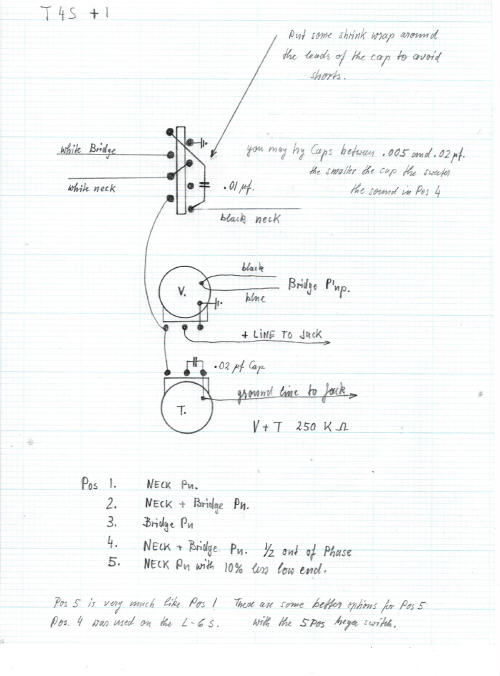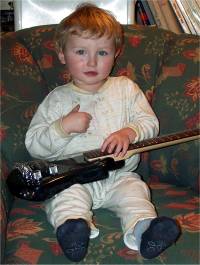Ray
Mod Emeritus
Heut war Vito C in meinem Stammladen (ommm) und erzählte beim Rumsimpeln was von einer oop-Schalte mit Lowpass. Coole Idee eigentlich, da hat man obenrum den näselnen Sound, aber trotzdem mit Fundament unten.
Bill Lawrence (ommm²) hat das angeblich erfunden, er hat dazu auch wirklich mal was in meinem Lieblings-Fenderforum geschrieben (peinlich, immer übersehn )
)
Die Zeichnung:

Bills Kommentar:
http://p082.ezboard.com/fguitarsbyfenderfrm27.showMessage?topicID=2.topic
Post #4.
Klingt ziemlich cool, obwohl ich die Schalte nicht so ganz verstehe. Aber das mit dem Kondensator ist nicht übel. Lässt bei einem PU erst gar nix bassiges durch, also kann auch keine Phasenauslöschung stattfinden. Also kommen von dem anderen PU die Bässe mit durch.
Aber was meint er mit "superposition principle"? Und mit gegenseitem "choke" bei den PUs? Kann das mal einer der Freaks (Onkelchen?) ins Dummdeutsche übersetzen? (Wörterbuch hab ich selber, aber ich meine halt in dem physikalischen Zusammenhang. ich kenn nen choke nur ausm alten Diesel....)
PS: Ich hab zuerst superstition principle gelesen und dachte, jetzt kommt irgendeine PU-Ironie
PPS: mit seriell oop klappt das dann aber nur wenn ich den Kondensator schaltbar direkt zwischen die beiden PUs klemme, oder?
Bill Lawrence (ommm²) hat das angeblich erfunden, er hat dazu auch wirklich mal was in meinem Lieblings-Fenderforum geschrieben (peinlich, immer übersehn
 )
)Die Zeichnung:

Bills Kommentar:
http://p082.ezboard.com/fguitarsbyfenderfrm27.showMessage?topicID=2.topic
Post #4.
Klingt ziemlich cool, obwohl ich die Schalte nicht so ganz verstehe. Aber das mit dem Kondensator ist nicht übel. Lässt bei einem PU erst gar nix bassiges durch, also kann auch keine Phasenauslöschung stattfinden. Also kommen von dem anderen PU die Bässe mit durch.
Aber was meint er mit "superposition principle"? Und mit gegenseitem "choke" bei den PUs? Kann das mal einer der Freaks (Onkelchen?) ins Dummdeutsche übersetzen? (Wörterbuch hab ich selber, aber ich meine halt in dem physikalischen Zusammenhang. ich kenn nen choke nur ausm alten Diesel....)
PS: Ich hab zuerst superstition principle gelesen und dachte, jetzt kommt irgendeine PU-Ironie

PPS: mit seriell oop klappt das dann aber nur wenn ich den Kondensator schaltbar direkt zwischen die beiden PUs klemme, oder?
- Eigenschaft


